#álfablót
Text
A gratitude ritual to the elves
(For the autumn season!)
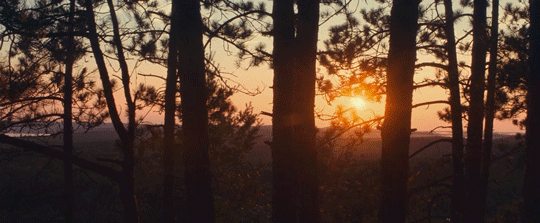
This is a ritual that I’ve created some two years ago, as a gesture of thanks and acknowledgement to the álfar as land spirits. It acts as the “closing ceremony” for the harvest season, so it could be fun for you to perform it on Samhain if you celebrate, or on your preferred date to perform the Álfablót. It’s made up of three major steps; the offering of drink, the offering of food and the burning of autumn symbols, all of which are separated by invocation and prayer. Without further ado, I will detail the ritual.
The first step? To bake/cook/prepare your offerings of food and drink. I think it’s important to incorporate local seasonal ingredients, as they come directly from the land you live on and therefore, can be considered gifts from the harvest Gods and spirits. Examples of seasonal drinks might be cider (apple juice also does the trick if you’re alcohol-free!), mead, mulled wine, spiced drinks and the like. Seasonal foods might be include apple, pumpkin, corn, squash, etc…
The final offering requires you to go and pick a few good, local symbols of autumn. These can be fallen leaves, helicopter seeds, fallen flowers… Basically anything that you know will burn well and which you won’t have to pluck directly from the tree or plant it comes from. If you grow herbs, fruits and/or veggies, it’s also possible to offer them up as well. I also write down on a piece of paper a few things I’m grateful to the álfar for.
Prepare a ritual bowl or cup in which to pour the offering of drink, a plate in which to place the food offerings, and a fireproof space in which to safely burn the autumn symbols (I use my cauldron).
Optional but fun: I line each plate up in the order drink-food-fire in an outside space and kneel before them to perform the ritual. I then light incense and anoint each plate with ritual rosemary oil, for purification and protection.

Invocation: “I call upon the spirits and guardians of my land. I call to me the people of Yngvi-Frej who dwell in Álfheimr. Come to me Hidden Ones, come and receive that which I humbly choose to give back, in thanks and as to show my gratitude.”
As you pour the offering of drink: “May you accept this libation, symbol of the water which flows under the earth and nourishes the soil. May you look with fondness upon me and those who dwell on your lands.”
As you offer the food: “May you accept this shared meal, symbol of the many gifts of the earth. May you bring forth favorable and plentiful seasons henceforth.”
As you burn the symbols of autumn: “Another harvest has passed, with your blessing and your protection. Noble elves who answer to the Vanir Son, I am grateful for the land that you share so generously with me and my loved ones. Please bless the soils to be bounteous for the coming year.”
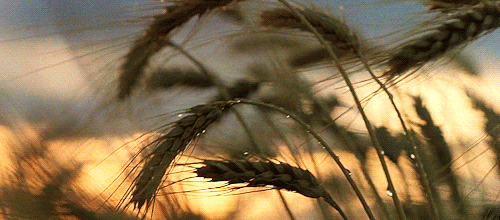
I hope you all have a happy autumn season (or spring, if you live in the southern hemisphere!).
#heathenry#Álfablót#elves#norse paganism#witchcraft#yngvi freyr#spirituality#norse gods#polytheism#deity work#deities#alfar#álfar#land spirit#spirit work#ritual#rituals
103 notes
·
View notes
Text
Happiest Halloween 🎃🌕 blessed Samhain 🔥💀 and god Alfablot 🍺👨👩👦
1 note
·
View note
Text
gonna kiss my husband on the mouth because he made me a really good pagan playlist that I've been listening to while writing rituals and studying for Vetrnætr
#[static]#going to perform the álfablót but I'm adjusting some of it to make sense in a more modern setting#but it's a lot of research especially since some of the older/still somewhat modern resources can be written by folks I dont -#- want to associate with#always take everything with a grain of salt and do a triple check lol
5 notes
·
View notes
Note
Idk what the "similarities between El Día de Muertos and Samhain" anon was trying to ask either, but I can tell you that every single year without fail I see at least one gringo on here (because it's always a gringo for whatever reason) who thinks Día de Muertos originated from Samhain or alternatively Álfablót
I guess they think Mexico is in fucking northern Europe or some shit
It's super confusing for sure.
If there's anything that's been pretty consistent though in my time as an experienced witch who answers questions on the internet it's that suburban white people are constantly trying to find ways to "get permission" to take whatever they want from other cultures -- whether they're open to them or not.
Like, think about how many asks I get about Lilith. I don't even publish all of them. It's remarkable how mad some folks get at the very idea that something's not "for them."
Additionally, at least with this one, there's the whole Margaret Murray influence that we just can't stomp out no matter how hard we try. They're looking for universal-Pagan beliefs in countries separated by an ocean. Whether the origins of the day of the dead were retconned or not, it's either Aztec or Spanish or a fuckin' mix of the two.
An Irish holiday has not entered the chat.
22 notes
·
View notes
Text
Anyways, since that time of the year is approaching, here's your annual reminder that Día de Muertos is not of Celtic or Old Norse origin and absolutely nothing to do with Samhain or Álfablót
34 notes
·
View notes
Text
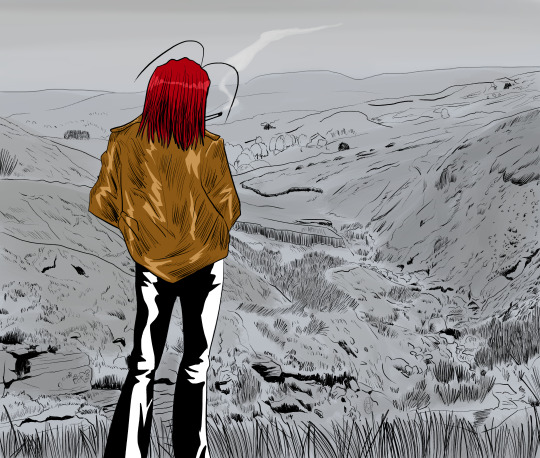
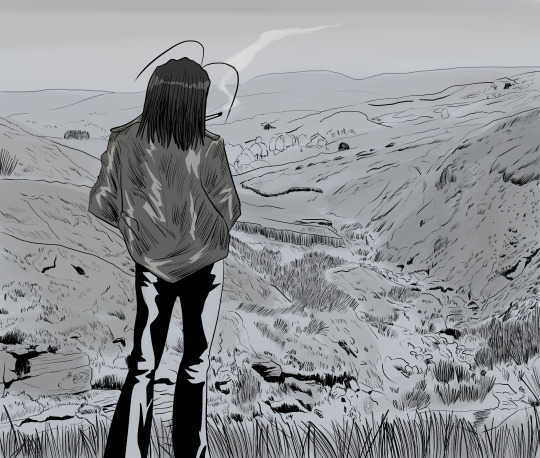
Monthly Minekura Christmas edition
Day 11 “Elf”
I know this might seem strange but the background is actually linked to the theme of 'elf' because that's Alden Valley, based on this photo that inspired me with the subject. Alden derives from Old English ælf ('elf') + denu ('valley'), thus meaning 'elf-valley'. I didn't want to use the Christmas version nor the Tolkien-based elves, and I couldn't find an equivalent in Chinese mythology. I prefer to stick with old traditions but it is complex and sometimes even confusing, so I preferred to use a place in England that was once associated with elves. Elves appear in some place names, though it is difficult to be sure how many of other words, including personal names, can appear similar to elf. The clearest English examples are Elveden ("elves' hill", Suffolk) and Elvendon ("elves' valley", Oxfordshire); other examples may be Eldon Hill ("Elves' hill", Derbyshire); and Alden Valley ("elves' valley", Lancashire). These seem to associate elves fairly consistently with woods and valleys. In Old English, elves are most often mentioned in medical texts which attest to the belief that elves might afflict humans and livestock with illnesses: apparently mostly sharp, internal pains and mental disorders. The most famous of the medical texts is the metrical charm Wið færstice ("against a stabbing pain"), from the tenth-century compilation Lacnunga, but most of the attestations are in the tenth-century Bald's Leechbook and Leechbook III. This tradition continues into later English-language traditions too.
Because of elves' association with illness, in the twentieth century, most scholars imagined that elves in the Anglo-Saxon tradition were small, invisible, demonic beings, causing illnesses with arrows. This was encouraged by the idea that "elf-shot" is depicted in the Eadwine Psalter, in an image which became well known in this connection. However, this is now thought to be a misunderstanding: the image proves to be a conventional illustration of God's arrows and Christian demons. Rather, twenty-first century scholarship suggests that Anglo-Saxon elves, like elves in Scandinavia or the Irish Aos Sí, were regarded as people. Keep in mind that like words for gods and men, the word elf is used in personal names where words for monsters and demons are not, so elves are people. In Old English, the plural ylfe (attested in Beowulf) is grammatically an ethnonym (a word for an ethnic group), suggesting that elves were seen as people.
Elves are known in Norse tradition, notably in Snorri Sturluson's Prose Edda, which talks about svartálfar, dökkálfar and ljósálfar, but these terms are attested only in the Prose Edda and texts based on and it is now agreed that they reflect traditions of dwarves, demons, and angels, partly showing Snorri's "paganisation" of a Christian cosmology learned from the Elucidarius, a popular digest of Christian thought (this is why I take with a grain of salt Prose Edda when I want to learn about Norse religion). I prefer to focus in Old Norse poetry, particularly the Elder Edda. Elves are frequently mentioned in the alliterating phrase Æsir ok Álfar ('Æsir and elves') and its variants. This was a well-established poetic formula, indicating a strong tradition of associating elves with the group of gods known as the Æsir, or even suggesting that the elves and Æsir were one and the same. There are other sources that talk about elves such as Sagas of Icelanders, Bishops' sagas, and contemporary sagas. In Kormáks saga there is the mention of álfablót ("elves' sacrifice"), and in Eyrbyggja saga we can find the existence of the euphemism ganga álfrek ('go to drive away the elves') for "going to the toilet".
Fun fact: by the end of the medieval period, elf was increasingly being supplanted by the French loan-word fairy. An example is Geoffrey Chaucer's satirical tale Sir Thopas, where the title character sets out in a quest for the "elf-queen", who dwells in the "countree of the Faerie".
I imagined Gojyo (I find him the best for these kind of works) being alone in this place, pondering about his life and letting thoughts roam freely before maybe elves try to steal them. Here you can see two versions, a black and white version which resemble a manga page and another one where Gojyo chromatically stands out. I was unsure which posting, so asked a dear friend of mine and she liked both and eventually I decided to post both. Gojyo's pose was partially inspired by the famous painting of Caspar David Friedrich, Wanderer above the Sea of Fog. Ok again sorry for long post.
Credits:
Saiyuki Reload Blast © Kazuya Minekura, Platinum Vision, 2017-present
15 notes
·
View notes
Text

— A FAIRYTALE BEGINNING | chapter 8
halcyonic mirage
pairing: Loki / f!half-Asgardian!Reader
word count: 4,436
summary: there is far more to the soulmate spell than your family has ever told you
in this chapter: the rest of the conflagration finally appears on page, more series lore, brief/non-descriptive discussion of blood magic and curses, Odin appearing briefly on page in the beginning, this chapter earns more points for the "idiots in love" tag, and so much hand-holding
author notes: hi! hello! how are all of my readers?
no this fic is not dead, nor am i. it's just been slowly roasting in the oven the last several months. i finished the first drafts of ch9 to ch22 back in November as part of NaNoWriMo, and have been slowly working my way through editing, rewriting, and finishing the rest of the fic since December. i picked up working on a few other wips along the way too, hence the long silence. my bad.
the good news: a few chapters are basically ready to go! i just have to finish working on some stuff with edits and rewrites for this, but for the most part a lot of this fic is written now.
( previous chapter | read on ao3 | series masterlist )

The feast is loud. Cheers, jeers, and the sounds of tankards being tossed to the floor ring across the entire Great Hall as Álfablót truly gets underway this evening.
You’re at a long table with friends and friendly faces, not far from where (hours ago now) the royal family sat to welcome the emissaries from Álfheimr. Now you’re sitting on top of the table, legs tossed over Loki’s lap as she traces shapeless lines on the palm of your hand she holds. You switch between jesting with the others in this mixed company, joking and telling tales with a few of your friends, and speaking quietly with only Loki.
As loud and exuberant as your friends are, and as boastful of their past and future deeds as Baldr and his friends are, you love this. You’re drunk on the bright atmosphere of celebration as you lay your head on Loki’s shoulder, and she continues to trace senseless patterns on your palm while the table laughs.
Somewhere out in the hall, your conflagration wanders and mingles with others. With Álfheimr’s emissaries, with visitors and ambassadors from various other realms, and with Æsir from all across this realm. The most glaring absence for visitors or ambassadors is the lack of Drekasál from Eldgard, Gymirsgard, or any other realm. There are only twelve dragons on Asgard, just as there’s been for as long as you can remember.
Near the head of the room, where the royal family sat, your father and uncle stand with the All-Father and the ambassador of Lakonía, one of the distant realms of Yggdrasil allied with Asgard. You have no idea what the four of them are discussing, nor do you care all that much. It’s likely politics or warfare related, knowing your father. You would rather focus on the revelry around you. On this celebration of Asgard’s peace treaty and alliance with Álfheimr.
That is, until you hear it.
There’s a sudden low hush that washes across the room in a quick wave. All the sounds of the feast suddenly drop in pitch. You hear the sudden drop-off of the skalds music, and that’s when your table finally turns its attention to the rest of the hall.
She strides through the hall without even a glance at those she passes. Like a goddess on a warpath. Dark in colour, the brightest points on her are the shining beads adorning her half-dozen braids and the bits of shining metal over dark leather. All eyes in the hall are on the stranger as she aims straight for the All-Father.
All three royal children rise slowly, Loki’s boots thudding softly on the bench seat as she drops your hand. The rest of your table tenses, readying for whatever signal they might give next. Your eyes flick quickly from Loki back to the woman, watching for whatever action your best friend chooses to take.
And then the stranger breaks free from the crowds, allowing you your first genuine look at her.
You notice the braids adorned in beads and the flashes of silver metal that protect her as she passes through the crowd. The combination isn’t remarkable. Most of the people here wear something similar, but then you spot the insignia emblazoned across her breastplate.
A down-pointed sword with the silhouette of two dragon-form Drekasál wrapped around the blade. An insignia that declares her to be a full-fledged himingarpr.
It says to you — and to others who know what it means for a Drekasál to become a himingarpr — this drekakona has a deep sense of loyalty to the Burning Crown, that she upholds the will of the Voiceless One, and that she has the desire to protect the lives of other Drekasál.
She is a dragon you can trust without reservation, just as you trust the himingarpar in your conflagration.
Even knowing what the insignia means, the sight of a new dragon in Asgard this evening shocks you. You can’t help but to reach out with your dragon-sense, checking what you’re already so sure of. Even from across the hall, you can feel that faint impression of her dragon. That distinct, irreplicable feeling you feel from every Drekasál in your conflagration. In your family.
Seeing the insignia and feeling her dragon, you relax. You take Loki’s hand, tugging lightly to catch her attention. When she looks down, you say loud enough that your entire table can hear, “She’s a himingarpr. She has the insignia, and I can tell from here she’s a Drekasál.”
At your words, the entire table relaxes, though they’re all still wary. It makes sense they are. For you, the drekakona’s arrival is little more than a curiosity; for them, she’s an unknown, even if she’s not a threat. She’s likely a last-minute ambassador from Eldgard, though you have no idea who she is. Asgard hasn’t seen a visiting Drekasál since the war between Asgard and Jǫtunheimr, so the arrival of an Eldgardian ambassador this year is a surprise.
When the drekakona stops several feet shy of the All-Father, he turns his lone eye on her, his horn of ale raised as if he was about to take a drink. Placing her left fist over her heart and lowering her head, she speaks loudly and clearly enough for her voice to be carried across the Great Hall.
“Hávi, it is an honour to stand before you. I am Helga, daughter of Tryggvi, who is the son of Thýri. I come to your realm this evening to continue my search for my soulmate. With your leave, I would like to begin my search in this hall before searching the city and then the rest of your realm in my quest to find them.”
Curiosity and excitement spark through you at her words. She’s not an ambassador, but (in your opinion) the truth of why she’s here is far more exciting.
Helga Tryggvadóttir has come to Asgard on her Soul Quest, a quest all Drekasál go upon to find their soulmate once they’ve come of age. It could take hours, or it could take centuries. Some might even put the quest on pause for other events in their life, but no dragon truly stops searching until they’ve found their soulmate.
Lady Tryggvadóttir looks up, dropping her hand back to her side. Her words were blunt, carrying all the grace of a dragon on the hunt. You wonder if you will be like that in a decade, when you are wandering Yggdrasil in search of your soulmate.
The silence that grabbed hold of the hall continues to ring through the air, and it feels as if it grows heavier the longer it goes on. You can’t remember a time when any feast has ever been this quiet for quite this long. A few seconds when something interesting catches the attention of the entire hall, but never longer than that.
You hear a goblet being dropped deep from the other side of the Great Hall. Then, finally, the All-Father dips his head at the drekakona and holds his hand out to her.
“Welcome to Asgard, Lady Tryggvadóttir. May your search in my realm be a short but fruitful one,” he says. Lady Tryggvadóttir places her hand in the old god’s, allowing him to give it a partial lift before the touch is broken. When he introduces her to your father, your uncle, and then to the Lakonían ambassador, you know that he’s not the soulmate she’s seeking. Such an occurrence would be subject to far more fanfare, especially considering who he is.
A quick touch of palms quickly establishes that neither your father nor the Lakonían ambassador is her soulmate, and after a few brief minutes of conversation, she excuses herself and slips back into the crowds to continue her search. The sounds of the feast had picked up after the initial introduction, but the volume level rises farther now that she’s slipped away from the spotlight.
Loki sits back down, her hand tucked between yours once more as the conversation at your table picks back up. You find yourself distracted, unable to keep your attention on the conversations around you. Your gaze keeps floating back out to the hall, continuously searching for glimpses of the drekakona as she weaves her way around groups. You watch as, time and again, Lady Tryggvadóttir stops to introduce herself and speak to various beings. She never lingers for more than a few minutes once she’s sure none of them is the soulmate she is seeking.
It fascinates you how so many watch her, even after she excuses herself from their presence. You wish she would drift closer to your table, so you might meet her, but you watch how steadfastly she moves in the opposite direction. She’d locked eyes with you just minutes ago, and you’d straightened up, hoping she would come over so you might meet her. Instead, she had excused herself from the noblewoman she spoke with to move away from your table.
Some part of you wonders if she’s avoiding you, though you can’t fathom why she might. You only want to meet her, to learn about her.
Lady Tryggvadóttir fascinates you in a way no other Drekasál has before. Daughter to a dragon you don’t know the name of, a himingarpr of no renown, and seemingly with no other purpose in visiting the Realm Eternal than to seek out her soulmate. The combination is what fascinates you about her. If she had come from a dragon of great renown or had made a name for herself, you would be far less interested in her. Yet here she is, an unknown dragon wandering the hall and conversing with so many who already have made a name for themselves.
In truth, it’s not her lack of prestige that fascinates you, but why she is here. She’s looking for her soulmate. Most of the Drekasál on Asgard don’t have a soulmate, but none of them ever leave to search for theirs either. They won’t tell you why, and you’d hoped maybe this new dragon would maybe be able to answer you since your conflagration refuses to.
Perhaps after tonight’s feast, you’ll be able to track her down and speak with her before she leaves the city. You have so many other questions for her as well. Your conflagration has lived in Asgard for so long now. What are the other realms like now compared to what your conflagration remembers?
Eventually, you lose sight of her as she wanders farther and farther from your table. You let yourself get lost in the conversations, trying not to dwell on the visiting drekakona. At least, not for the evening. You’ll enlist whoever you can to help find her tomorrow.
You’re finishing off another goblet of the sweet berry juice you’re so fond of when Loki tugs your hand to get your attention. When you look away from Gauti, and one of the young Einherjar trainees you’ve forgotten the name of, she’s looking at you with wide, gentle eyes, and a soft smile.
“Come dance with me?” Loki asks, tilting her head towards where other feast-goers have started line dancing.
The music has changed from general revelry to songs for dancing. Now that you’re paying attention to the melody, you can feel the urge to clap and dance with those already dancing. And yet, when Loki stands up and holds a hand out to you, you hesitate, goblet at your lips as you stare at her.
That half-second hesitation seems to be a bit much for Thor.
"Go dance with my sister, Firefly!" Thor says, gently — but with plenty of force — pushing against your back. That large, exuberant smile he's known for is on his face, encouraging you on. Gauti and the Einherjar trainees are quick to encourage you to leave and dance with Loki too. You can feel warmth blazing across your face, surprised at the sudden insistence from everyone that you dance with your best friend.
At the other end of the table, Baldr lifts his goblet into the air.
"Here here! Go dance, little dragon! Show my sister what a great dancer you are!" Baldr cheers. Baldr’s friends are quick to joining the cheer.
You laugh, a bit nervous from suddenly having the entire table cheering you on. Still, after a few more moments you place your hand in Loki's and stand from your seat atop the table. A roar of cheers from the table go up, and several tankards and goblets are tossed to the floor. You can't help but smile a bit sheepishly as Loki helps you down.
Your goblet clatters onto the table as Loki pulls you away from it, leading you towards the group of people dancing.
The line dance is one you both know well, so it’s easy for both of you to slip in at the end and join them. With every turn, every clap, every jump, it seems like the world grows brighter. Loki’s face is lit up with a wide grin as the two of you mirror the other dancers. Her joy is contagious as she takes your hands, twirling you around her as she leads the both of you through the steps. So much so that it envelopes your heart, making the room shine ever brighter. Soon enough, you’re laughing too as she spins you away from her, hopping into the air as you twirl around before returning to her side.
In perfect harmony with Loki and the other dancers, you step, twirl, and clap in time to the music. The more the tempo picks up, the more it all blends together. The movements, the sights, the sounds. It’s a moment of freedom, of sheer joy as you dance with Loki, never wanting to look away or let your hands leave hers even when they have to.
There is a sudden jump in noise from the crowd, one that you don’t pay attention to. You’ve been to enough of these feasts that you’ve learnt something will always cause a scandal, and you’d rather enjoy this dance than pay attention to whatever the cause of gossip is tonight. You’ll hear about it tomorrow, you always do.
It’s only when the music slows — and then stops mid-dance — that you take a moment to listen, and realise what everyone is talking about.
Lady Tryggvadóttir has found her soulmate.
Her soulmate is Lord Ivarr, Lady Katla’s heartmate.
You dart off into the crowd without waiting to hear more, pushing your way past and dashing between groups to where you know the conflagration usually gathers during these events. A flurry of words dances in and out of your ears from every group you pass, none of them sticking long enough for you to understand what’s being said. When you finally reach where their table is, you stop.
Lady Katla is sitting alone, looking lost in thought as she stares towards the far doors that lead out of the hall. While Lord Tórbjǫrn stands only a few feet away, he’s speaking with Lady Ásta, though his eyes keep darting back to his sister as he does. Lord Hákon is sitting on the table, much as you were earlier, while your mother, uncle, and Lady Brynja form a half-circle around him. Lord Félagi is nowhere to be seen (though this doesn’t surprise you too much, considering what you know about the drekamaðr). Lord Ivarr and Lady Tryggvadóttir are also absent, which both confuses and surprises you.
Gauti comes from your right, moving right past you and heading towards his mother, Lady Ásta. Loki appears on your left, stopping beside you.
“Where are they?” She asks in a whisper. Like you, she’s looking around, trying to see if she can spot the newly bonded pair.
You can’t help but wonder if you would care as much about who Lady Tryggvadóttir bonded to if it hadn’t been Lord Ivarr. If her soulmate wasn't a beloved part of your family.
“I don’t know. They weren’t here.”
You take Loki’s hand, the two of you closing in the half-circle around Lord Hákon. The four dragons look at Loki, assessing her in a way that (for reasons you can’t put a name to, but that you can feel) annoys you. You glare at them, though Lord Hákon lets out a brief chuckle at your glare.
“Suppose you’re wondering where they are, little dragon?” Lord Hákon asks with a smile.
“We heard, well, everyone talking about it,” you tell him, glare disappearing. You’re wondering if you misunderstood their looks at Loki because of the drekamaðr’s rather relaxed attitude when he speaks.
“Firefly wanted to meet Lady Tryggvadóttir, so we came over to see her now that she’s bonded to Lord Gunnarsson. Where have they gone?” Loki’s voice is firm, with not an ounce of give in her words as she looks around. You can’t help but look at her with a bit of awe at how she stares four dragons down with steel in her spine. Even Thor and Baldr give a little when the conflagration turns their eyes to them, but Loki doesn’t seem bothered at all by having so many dragons staring at her.
“Gone, for the evening at the least,” Lord Hákon tells her with a shrug of his shoulder. “We won’t see them until they’re ready. Could be tomorrow. Could be a week from tonight. All up to them.”
You turn to your mother and uncle, the question on the tip of your tongue. Your mother answers it before you’ve even said a word.
“Newly bonded pairs spend time alone until they’re both ready to be seen together again. This is normal, little starlight.”
“How long was it before you and Uncle Sveinn were seen again?”
“Three and a half days. That’s close to average. Part of the time is spent learning about each other, especially if you don’t know each other before the bond shows itself.” She places a gentle hand on your cheek, smiling at you. “You’ll see, some day.”
You frown, disappointed that you won’t see either dragon for several days at least. Still, if no one else is concerned…
Your eyes look past the other dragons, to Lady Katla. She’s still sitting there, alone and looking almost like she’s longing to be anywhere else but this hall. Is she concerned? Is she worried about Lord Ivarr? He’s one of her heartmates after all; you can’t imagine Lady Katla not being worried for him with all that Lord Ivarr means to her.
Letting go of Loki’s hand, you walk away from the others to where Lady Katla sits. When you stop next to her, she looks up at you, blinking almost like she’s in a mild daze. Something inside you softens, saddens. You sit down next to her, neither of you speaking for several long moments.
“You just looked lonely,” you tell her, softly enough so only she can hear you. “I thought you might want a friend.”
Her eyes widen, and she blinks a few times before she gives a slight smile.
“You are an odd drekabarn, little firefly.”
You can’t help the smile you give her as you say, “I know, Lady Katla.”
“Katla,” she says as she looks away once more. “Just Katla.”
◦ ◦ ◦ ◦ ◦ ◦ ◦ ◦ ◦ ◦ ◦ ◦ ◦
“… and that is how the High Lady Auðhild discovered that, in certain cases, blood magic can be used to craft a tracking spell,” Frigga concludes, shutting the tome in her lap. “Are there any questions?”
You look up from your holotablet, where you’ve been taking notes and doodling along the way. You’re relaxed against a few of the myriad of pillows decorating the almost black-looking divan. There’s a thick chill in the air on this early winter morning, even with the warming spell that Frigga has placed on the room for the duration of winter. The cold makes itself at home in the room as the three of you finish up your last blood magic lesson. A large, warm blanket lays across your lap, stretched across the length of the divan to cover Loki as well. Loki’s legs are intertwined with yours at an angle, their weight warm and comforting.
You shake your head, shutting off the screen of your holotablet as you lay it in your lap. The lesson itself had been rather straightforward in how limited tracking spells with blood magic are, even if they’re the most accurate of any tracking spell branch. Item-essence tracking spells (tracking spells used on items owned by a person long enough that they’ve left an imprint on the item) are far more common for a reason, despite having a lower location accuracy and less reliability.
“I have a question,” Loki says, leaning forward and tossing her holotablet next to her legs. When Frigga looks over at her daughter, Loki says, “The Drekasál call it a soulmate spell, but that doesn't quite make sense when looking at it as a whole. So I wondered, is it actually a blood curse?”
You whip your head to your left to look at your friend, eyes widening at her question. A blood curse? Does Loki truly think that the soulmate spell might be a blood curse? On an entire species?
You can barely comprehend how many components a spell like that would need. You only know a fraction of what comes with the soulmate spell. The bits and pieces that you’ve seen or been told about. There are parts that you don’t know anything about, parts that you barely know anything about from the others who have brushed over them when speaking of their bond. The recent bonding of Lord Ivarr and Lady Tryggvadóttir has reminded you of how much you still have to learn before you come of age.
The true breadth and complexity that the soulmate spell might encapsulate begins to overwhelm you as you remember all that you know of it already. You feel a little light-headed the more you think about it.
Frigga is quiet as she rubs her thumb against the palm of her other hand. You know that gesture well. It’s a nervous, anxious gesture Frigga makes sometimes, one that Loki has picked up from her mother. Frigga is collecting the words necessary to answer Loki’s question. The sight of the gesture makes you uneasy because it means that Loki is on the right track. Loki has put together pieces you hadn’t thought of, hadn’t even seen until she pointed it out.
“The true origin of the soulmate spell is as shrouded today as it was the day it was cast. Both of you know this. Even I am in the dark about its truth,” Frigga confesses. You know that she has some capacity for clairvoyance, but it also doesn’t surprise you that the seiðkona doesn’t know the spell’s origin.
Whoever cast the spell, they cast it long before Frigga was born. The spell was studied intensely in the first decades after it was cast, and then practically discarded after a few centuries passed with no genuine answer as to its cause. Even with her ability, Frigga wouldn’t have been able to see who had cast it or why.
Frigga tilts her head, folding her hands in her lap as she casts her eyes towards her garden. “From what I know about the spell, it’s known that blood magic was a component of the larger spell that was cast. Whether that component was a blood curse or a blood spell is harder to determine.”
“What do you know about it?” you ask. “About its origin and how it works?”
“I know a little more about the spell’s origin than our scholars and archivists, and only because I understand seiðr and magic in a way most do not,” Frigga begins. She gets more comfortable on her divan by tucking her feet in and readjusting her blanket. It’s a signal to both of you that she expects this to be a longer discussion, and to get more comfortable if you’re not already.
You sit up, tucking your legs close so that they face away from Loki. You tuck the blanket around your shoulders, laying your hands across your lap beneath the blanket to keep them warm. Loki stretches her legs over the divan’s edge, legs tangled up in the blanket while she leans against you. Once the three of you are situated and comfortable, Frigga continues speaking.
“I’ve taught you that mixing the different branches of magic can be difficult, if not dangerous. Few branches mix well with others,” she says. Her words are measured and careful, emphasising a lesson that she’s repeated time and again over your training. Never mix magic branches unless you know they’re compatible, or risk the high probability of weaving together a hazardous spell. “We don’t know the origin of the spell, and we only have guesses on many of the components used to cast such a massive spell. But anyone well-trained in seiðr and magic can tell you this: the spell was cast combining blood magic and soul magic.”
An uneasy, almost fearful feeling skitters down your spine, raising the hairs on your neck and leaving goosebumps down your arms.
Blood and soul. Two branches of magic that mesh so well but whose mixtures can result in the most horrific of outcomes if done wrong. Your mind begs you to wonder if what happened to your people was an accident, or if it was the desired outcome. Both are possibilities, and both are equally chilling.
“Only Drekasál were affected by the spell. No other group was. Like they were the only ones the caster targeted,” Loki says softly. You can practically see her mind running the combinations and probabilities as she tries to shred apart the facts in her mind in search of the truth. “It affected all of them. Young and old, born and unborn, full-blooded dragon or not. Every Drekasál in Yggdrasil and beyond was affected. Even now, everyone with Drekasál blood is cursed.”
Cursed.
Before today, you’d never heard the word be applied to the spell that leaves your world in monochrome. It fits perfectly, though, for it to be called a curse instead of a spell. To be cursed is to be afflicted by something; monochromacy afflicts all Drekasál until they’ve reached maturity and touched the skin of their soulmate.
Your view of the universe shifts ever so slightly as you realise this. Even this slight shift is nothing short of violent and jarring. Your people — you yourself — were not simply bespelled accidentally by some ancient magic that was cast.
All of you were cursed.
( next chapter )

@ladydracona @huntress-artemiss @sarahscribbles @mischief2sarawr

Find the lore notes for this chapter here!
Join the taglist for this series (and other works) here!
#loki x reader#loki x you#loki x y/n#loki imagine#loki laufeyson x reader#loki laufeyson x you#loki laufeyson x y/n#a fairytale beginning#the prince and his dragon#of fire and of ice#amphi writes
22 notes
·
View notes
Text
important!
the post on the holidays will he a guideline for those that want new ideas or don't know how to celebrate them at all. there is no one correct way :)
#norse pantheon#norse gods#norse mythology#norse heathen#norse pagan#norse paganism#norse pagan witch#norse polytheism#heathen#heathenry#norse heathenry#norse holidays#paganism#pagan witch#paganblr#pagan#beginner pagan#baby pagan#witchcraft#baby witch#beginner witch#witches of tumblr#witchblr#polls#poll#tumblr polls
24 notes
·
View notes
Text
Hey norse pagans! *Leans close and whispers*
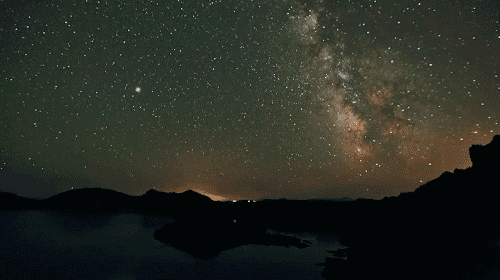
Reconstructing historical festivals and holidays is especially tough for us, isn’t it? Because there’s just so little evidence of anything, and even though Håkon the Good gave us a pretty good idea of some historical practices, it’s far from enough to have a clear idea of the actual celebrations, right? Plus, I bet your schedule’s tightly packed and that at least twice a year, you find yourself going: “Is it already [insert holiday]???”, and “crap, I forgot to prepare this or that for [insert holiday]”. Well my friend, let me tell you two important tips I’ve learned from years of trying to keep up with the proverbial wheel of the year. The first: holidays aren’t mandatory, especially not if you practice paganism alone, and especially since we know so little of holiday celebrations within germanic tribes, and during the Scandinavian Iron Age. Second *leans closer*: there’s nothing keeping you from making up your own festivals! If history hasn’t left us a lot of evidence on how your main deity/deities was worshipped, who’s to keep you from picking a spot on the calendar and going: “this day is all about [insert deity]”. You’ll have the possibility of listing out pre-determined rites and offerings. Are you going to sing songs? Recite poems? Decorate? Is there a symbol that’s prominent on that day? There are many ways to honor deities, and it’s fun to give oneself a chosen structure to follow when it comes to deity worship. Plus, it’s all the more rewarding to celebrate the seasons according the weather in one’s own area! I’m usually not in the mood to celebrate the coming of spring when it’s still -30 Celsius outside. In that regard, I give myself the leeway to diverge from historical practice and to celebrate the coming of spring when its does actually start to feel like spring! The crops are reaped a bit earlier than the 31st of October, in my area. For this reason, my Álfablót usually happens halfway through that month, and is spread out onto three days (the first for the ancestors, second for the álfar, and third for Freyr). So don’t hesitate to think up your own little holidays, and play around with the freedom it gives you! Just to give you guys a few ideas of where to start with this, I’ll add a little “holiday starter pack” right below!
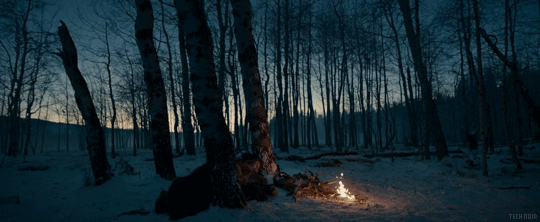
Step one: choose the date! Is there a day of the week that’s associated with your chosen deity/deities? A season, or type of weather in particular? Maybe a time of day?
Step two: figure out the general “mood” of the holiday. Do you want it to be a time to party? To be grateful? To connect with loved ones? To be at peace? Or a time of self-reflection and silent introspection? (Every year, I dedicate a full day of silence to Víðarr.) What’s the goal of the holiday? What are you celebrating?
Step three: think of some ritual offerings! It’s no big deal if, for whatever reason, you can’t actually offer them up: the idea of these offerings will suffice to help you define this holiday better. Will you be offering a specific food, or drink? Or a particular craft, or a depiction of an animal?
Step four: will you be decorating? If so, what’ll serve as the theme for decorations? Are you going to buy them or make them yourself?
Step five: is there an activity, or activities that you would want to engage in to honor the deity/deities on this day? If so, what’ll it be? I love to cook to honor Freyr, for example (this year, I made a seasonal pumpkin soup in His honor)! You could also go swimming for Rán and Ægir, or take a walk in the woods for Jörð. What do you think would please the deity/deities this day is dedicated to?
Step six: will you be inviting someone, or people over? It doesn’t matter if they’re pagan or not: if you want to celebrate with friends or family, any excuse is good to invite people over! Still, even if you celebrate alone, you’re certain to have lots of fun! So don’t worry about this last step if you feel uncomfortable with it.

#heathenry#norse paganism#norse gods#deities#deity work#spirituality#polytheism#norse polytheism#tips#paganism#festival#pagan holiday#rituals
310 notes
·
View notes
Note
What was the function of Winter Nights as a celebration?
Presumably it had many different overlapping functions. It's probably the best documented of the three major blóts (hǫfuðblót), but the sources are still not adequate to draw conclusive conclusions about anything.
Strictly speaking, Winternights (vetrnætr) is probably not the name of a celebration but the time of year (though vetrnáttablót 'Winternights blót' is attested in Gísla saga). It continued to be observed after conversion to Christianity and on to the present day. On the modern Icelandic calendar, it's the last two days of summer. Some early modern sources are in disagreement with each other about some details. This year it begins October 20 according to the University of Iceland's almanac (since it's two days, but three nights, I presume this to mean it starts on what we would call the evening of the 19th, and that winter actually begins on the evening of the 21st, also included in Winternights, though I'm not actually certain about that). Furthermore, since winter precedes summer, Winternights may have been considered an observation of the year ending and beginning ("heathen new year" so to speak). We have no evidence that they maintained a count of years equivalent to, like, "it's 2022 A.D.," so if this "new year" had any administrative importance, it's probably that it served as a deadline for some things that might have been ordered at the previous alþing.
In the sagas we see frequently that people chose that timing to have big parties that many people attended. Food would be abundant around then because harvests would be complete and animals recently slaughtered. Rich and powerful people sometimes took Winternights as an opportunity to made grand displays of generosity that both showed off their wealth and secured the loyalty of their followers. It was a popular time to hold weddings. Religious observations are mentioned frequently in connection to Winternights, such as blóts to Freyr (Gísla saga), and the famous description of a blót attended by Hákon góði in Heimskringla occurred at Winternights. There is also significant evidence that the dísir were celebrated at this time by some people (especially Norway), although it seems that others in Sweden were more likely to celebrate the dísir in the late winter/spring. Some people believe that the álfablót (a strictly private occurrence) mentioned in Heimskringla also occurred then, but I disagree; it's part of a series of events that begins at approximately Winternights, but must be later in the year to account for travel time. Either way, there is little reason to assume that this particular alfablót is characteristic of widespread contemporary customs, though it could be related to Freyr being worshiped at Winternights as mentioned before.
I'm going to isolate this for repetition because many heathens seem to have trouble with it: in sources founded primarily in Norwegian and Icelandic customs, the dísir tend to be singled out for worship around the time of Winternights, and this is where the term dísablót comes from. In sources founded primarily in Swedish traditions, the dísir seem to be singled out for worship in the late winter/spring, and this is the context we get the word disting (< dísaþing) from. These are two separate things, and neither seems to be universally "Norse." See the Terry Gunnell article I will link to at the end for more.
In more recent times in Iceland, veturnætur was also the time for making predictions about the winter through methods like observing the behavior of mice and birds. There was a tradition of "reading" the Milky Way (vetrarbraut, literally 'winter-path') from east to west, with light and dark spots meaning good or bad weather (there is apparently disagreement over which is which). Using sheep spleen and/or intestines to predict the weather seems to have also been done (consider that, since this was slaughter season, entrails would have been abundant).
There is some speculation that dísir and/or other invisible beings, especially female ones, were more pertinent or influential during the winter, and that Winternights on one hand, and the end of the winter on the other, are liminal times of transition into and out of this period. For this, as well as more detail on some of what I've already said above, see "Season of the Dísir: The Winter Nights, and the Dísablót in Early Medieval Scandinavian Belief" by Terry Gunnell.
For more further reading on the social role of holidays see An Arena for Higher Powers by Olof Sundqvist, for calendar stuff see Jul, disting och förkyrklig tideräkning by Andreas Nordberg (Swedish but with a substantial English summary at the end) and/or "The Festival Year: A Survey of the Annual Festival Cycle and its Relation to the Heathen Lunisolar Calendar" by Josh Rood.
Other sources for this post were almanak.hi.is, the actual printed Háskóli Íslands almanac, and Saga Daganna by Árni Björnsson.
61 notes
·
View notes
Text

So exactly what the fuck is it with gringo Heathens and their weird conspiracy that Indigenous Mesoamerican (and modern Mexican) cultures originated from the Old Norse? Yes, I know. It's racism and white supremacy. But like exactly what the fuck are the origins of this conspiracy in particular?
I cannot count how many fucking times I've run into gringo Heathens who are into this shit. Gringos who are convinced that the Toltec emperor Ce Acatl Topiltzin was a white Nordic man. (He was not). Gringos claiming limpia con huevo originated from an "Old Norse" practice (It did not. The exact origins are murky but right now the prevalent theory is that it either originated from Indigenous Mesoamerican cultures or was introduced to Mexico — and the rest of Latin America — by enslaved Africans. The Old Norse have fuck all to do with limpia con huevo). Gringos claiming that Día de Muertos originated from Álfablót (Again, no). Gringos claiming Santa Muerte is Hel (She is not). And that's just the shit I remember off the top of my head!
And I say gringos because it's mostly them pulling this shit. That isn't to say that white Heathens from countries like Sweden, Canada, or Australia don't also pull this. But again, it's mostly the fucking gringos. What exactly is going on here?????
1 note
·
View note
Text
✨Emojis for Heathen festivals ✨
Yule 🐗 🎄🍲❄️⛄️ 🎅🏽Mōdraniht 🤶👵🏽👩🦳👩🦰👩🏽Álfablót 🧝♀️🧝🏻🧝🏻♂️Dísablót 👵👵🏽🤶🧙🏼♀️Þorrablót 🔨🍺Disting 🚜🌱🌾Lenzen 🌸🌷🌼Hrēpmōnab 🌏⛰️🏔️Sigrblót ⚔️🗡️Midsummer/Litha 🌅☀️🌄🌿Lammas 🌾🌽🍻🍺🍞🥨Sunwait 🕯️🔥⛅️☀️
(just my suggestions, add your own as desired)
For more information on Heathen festivals, check out the Wikipedia page about them.
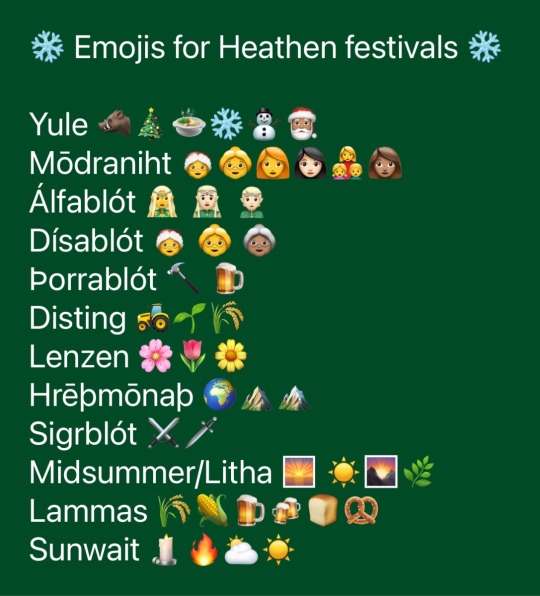
View On WordPress
1 note
·
View note
Photo
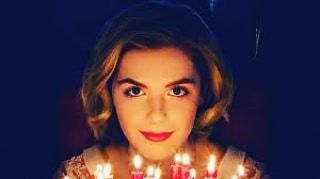
Just started watching this show last night. It felt like a fitting way to begin ringing in the samhain/vetrnætr/álfablót/Halloween. Without giving anything away, I think it's an interesting take on a theme I've always loved. I can find lots of inspiration for cool projects in it for you all! Are you watching the show? Comment "yes" if you are, and leave a 💓 if you're liking it so far! Find magic in the seemingly mundane. Samhain/Halloween is coming. What magic to do see around you? * * * * * * * #samhain #halloween #álfablót #vetrnætr #thechillingadventuresofsabrina #tcaos #sabrinaspellman #modernmagic #urbanfantasy #witch #witchy #witchesofinstagram #gay #geek #spooky (at Henrietta, New York) https://www.instagram.com/p/BplIcYXgEj_/?utm_source=ig_tumblr_share&igshid=1j1d7n7qccyq5
#samhain#halloween#álfablót#vetrnætr#thechillingadventuresofsabrina#tcaos#sabrinaspellman#modernmagic#urbanfantasy#witch#witchy#witchesofinstagram#gay#geek#spooky
1 note
·
View note
Photo

Similar to many ancient cultures, Northmen believed that just before winter set in, the veil between worlds was thinner. But unlike their Celtic descendants who celebrated “Samhain” or Halloween, they participated in Álfavlót.
The word itself means “Sacrifice to Elves”. Blóts were a sacrifice in the form of sacramental drink, meals, or a feast which is traditionally placed over a stone altar, a shrine, a grove, or in this case a burial mound. A feast of meat and beer was served in family homes and the male heads of households would act as the Ölvir, the beer masters, and presided over the private ceremony.
The Álfablót was a sacrifice to the Dökkálfar, the dark elves who reside beneath the ground of Midgard. It was also a time to connect with their ancestors, who many considered to be elves themselves due to their location in underground burial mounds. Many Northmen would sit on burial mounds during this time in order to connect with the Dökkálfar and their ancestors, often reaching meditative states deep enough to connect beyond the veil.
Within the name “Dark Elves” darkness is not seen as evil, but a power that is meant to be respected, especially in the cold months of a harsh winter, and by providing a feast for the Dark Elves the Northmen prayed that they would be treated with benevolence.
So this Halloween, remember your fallen ancestors beneath the crust of Midgard. Toast to them with beer and meat. Give thanks to the God Freyr, as he is the patron god to the elves. And hope for the benevolence of the Drökkálfar this winter season.
~Rayne~
#Viking#northmen#New Kattegat#halloween#álfablót#dark elves#norse#norse paganism#norse mythology#samhain
89 notes
·
View notes
Photo
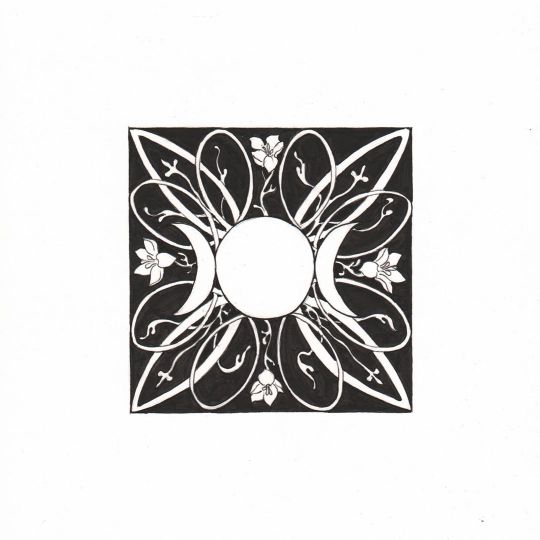
Samhain blessings to all who practice. May gods keep you safe and Full Moon give you the strength and wisdom you need.
#redbubble#society6#teepublic#inktober#inktober2020#inktober52lunar#lunar#инктобер#інктобер#samhain#sauin#alfablot#álfablót#hecate#triplemoon#triplegoddess#witchyvibes#moonwitch#moonwitchcraft#moonaesthetic#moonaesthetics#witchyaesthetic#moonspell#blackandwhite#blackandwhiteartwork#celticknots#vikingknots#heathen#paganborn
0 notes
